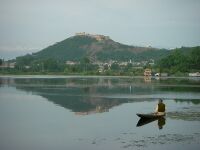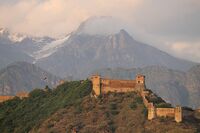Hari Parvata
| Author:Laxman Burdak, IFS (R) |

Hari Parvata (हरि पर्वत) is mentioned in Vishnu Purana (2,4,41) as name of a Mountain in Kuśadvīpa.
Origin
Variants
- Hariparvata (हरि पर्वत) (AS, p.1008)
- Hari Parbat
- Koh-i-Maran
- Kohe Maran
History
Hari Parbat
Hari Parbat, also called Koh-i-Maran [1] , is a hill overlooking Srinagar, the largest city and the capital of the Jammu and Kashmir, India. It is the site of a fort, built by the Durrani Empire, and of a Hindu temple, mosques, and gurdwara. The Indian government on 15 August 2021 (the 75th independence day) hoisted a 100 feet tall Indian flag on the top of the fort.[2]
Durrani Fort: The first fortifications on the site were constructed by the Mughal emperor Akbar in 1590 who built an outer wall for the fort as part of his plans for a new capital at the site of modern-day Srinagar city in Kashmir. The project, however, was never completed. The present fort was built in 1808 under the reign of the Governor of Kashmir Province of the Durrani Empire, Atta Mohammed Khan.
In 1947, consequent upon partition of India, Jammu & kashmir remained with India after the famous treaty signed by Maharaja Hari Singh. Since then Kashmir Valley along with this fort is an integral part of India. Today, the fort is well secured with the presence of Indian troops of the Indian Army and the paramilitary force CRPF, Rashtriya Rifles.
The fort can be reached via two sides of the city, (a) via Rainawari through Kathi Darwaza Gate and (b) via Hawal through the Sangin Darwaza Gate. The fort was closed for almost 2 decades and thrown open to the public in 2007.
Hindu temple: According to a legend, the area of Hari Parbat was occupied by Asura Jalobhava. The local Hindus prayed to Parvati (Shiva's consort) for help. She took the form of a bird and dropped a pebble on the Asura's head, which grew larger and larger until it crushed the demon. Hari Parbat is revered as that pebble, and Parvati is worshipped as Sharika (as cosmic energy pervading the universe) occupying the middle part of the western slope of the hill where there is a temple of Shakti, who is worshipped there under the name Jagadamba Sharika Bhagawati (or, simply, Sharika). She is depicted as having 18 arms and sitting in Shri Chakra.[3][4]
Muslim shrines: The southern side of Hari Parbat features Makhdoom Sahib, the shrine of Hamza Makhdoom, a 16th-century Kashmiri Sufi saint locally known as Hazrat Sultan and Sultan-ul-Arifeen.[5] Built below the fort is a mosque dedicated to Shah Badakhshi, a 17th-century Qadiri Sufi saint. The mosque was built by Mughal princess Jahanara Begum.[6]
Gurdwaras: Gurdwara Chatti Patshahi at Kathi Darwaza, Rainwari, is believed to be the place where Guru Har Gobind, the sixth Sikh guru, stayed for few days while travelling through Kashmir.[7] Gurdwara Guru Nanak Dev is a place where Guru Nanak sat and had discourse with people in early sixteenth century. It was earmarked with a pedestal by Mohammad Ata Khan, a general of Akbar who built the Durrani Fort. A small Gurdwara was later built at the place by Guru Har Gobind.[8]
हरि पर्वत
विजयेन्द्र कुमार माथुर [9] ने लेख किया है ....1. हरि पर्वत (AS, p.1008): विष्णु पुराण 2,4,41 में उल्लिखित कुशद्वीप का एक पर्वत जो कुशद्वीप में स्थित है--'विद्रुमो हेमशैलश्च द्युतिमान् पुष्पवांस्तथा, कुशेशयो हरिश्चैव सप्तमो मंदराचल:' [10]
2. हरि पर्वत (AS, p.1008): हरिवर्ष
हरि पर्वत, श्रीनगर

हरि पर्वत जम्मू-कश्मीर की राजधानी श्रीनगर में डल झील के पश्चिम ओर स्थित है। इस छोटी पहाड़ी के शिखर पर इसी नाम का एक किला बना है जिसका अनुरक्षण जम्मू कश्मीर सरकार के पुरातत्व विभाग के अधीन है। इस किले में भ्रमण हेतु पर्यटकों को पहले पुरातत्त्व विभाग से अनुमति लेनी होती है। क़िले का निर्माण एक अफ़ग़ान गर्वनर मुहम्मद ख़ान ने 18वीं शताब्दी में करवाया था। उसके बाद 1590 ई. में मुग़ल सम्राट अकबर द्वारा इस क़िले की चहारदीवारी का निर्माण करवाया गया।[11]
पौराणिक सन्दर्भ: एक पौराणिक कथा के अनुसार, पौराणिक काल में यहां एक बड़ी झील हुआ करती थी, जिस पर जालोभाव नामक दैत्य का अधिकार था जो लोगों को खूब सताता था। तब लोगों ने भगवान शिव की अर्धांगिनी एवं कश्मीर की अधिष्ठात्री देवी माता सती से सहायता की प्रार्थना की। तब सती माता एक चिड़िया का रूप (शारिका) धारण करके प्रकट हुईं एवं उस राक्षस के सिर पर एक छोटा सा पत्थर रख दिया जो धीरे-धीरे आकार में बढ़ता गया और राक्षस का सिर कुचल गया। हरी पर्वत पर एक बड़ा मन्दिर है जिसे शारिका देवी मन्दिर कहते हैं। यहाँ पार्वती की शारिका के रूप में पूजा की जाती है।
इसी पर्वत पर एक गुरुद्वारा भी स्थित है। इसे छट्टी पादशाही का गुरुद्वारा भी कहते हैं जो रैनावाड़ी में स्थित है। कहते हैं छठे सिख गुरु हरगोबिन्द सिंह यहां पधारे थे।
External links
References
- ↑ 1. Asher, Catherine .B (1992). Architecture of Mughal India. Vol. 4. Cambridge University Press. p. 124. ISBN 9780521267281. "In Kashmir's capital city , Srinagar , Akbar had constructed a massive fort on a high hill known as the Koh - i Maran or Hari Parbat overlooking Dal lake ." 2. Kashir Encyclopedia (in Kashmiri). Vol. 1. Jammu and Kashmir Academy of Arts Culture and Languages. 1986. p. 403.
- ↑ "India at 75: 100-feet tall national flag hoisted at Hari Parbat Fort in Srinagar - Hari Parbat"
- ↑ Nilamata Purana.
- ↑ Excelsior, Daily (14 June 2014). "Hariparbat-The abode of Goddess Sharika"
- ↑ Hamza Makhdum
- ↑ Asher, Catherine B. (24 September 1992). Architecture of Mughal India. Cambridge University Press. p. 215. doi:10.1017/chol9780521267281. ISBN 978-0-521-26728-1.
- ↑ "Gurudwara Patshahi Chevin, Village Rainawari". AllAboutSikhs.com.
- ↑ "Gurdwara Guru Nanak Dev Ji, Hari Parbat, Sri Nagar". www.sikhphilosophy.net. Sikh Philosophy Network.
- ↑ Aitihasik Sthanavali by Vijayendra Kumar Mathur, p.1008
- ↑ Aitihasik Sthanavali by Vijayendra Kumar Mathur, p.859
- ↑ भारतकोश- हरिपर्वत क़िला श्रीनगर

